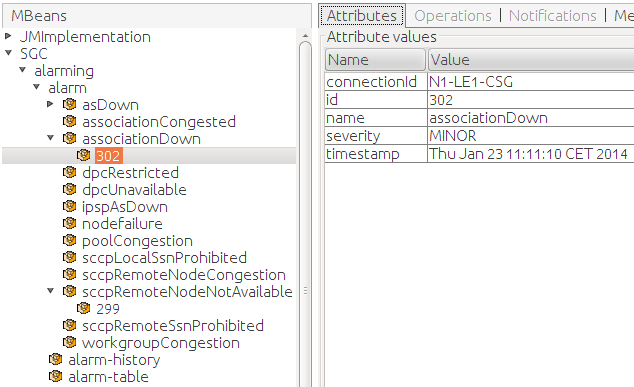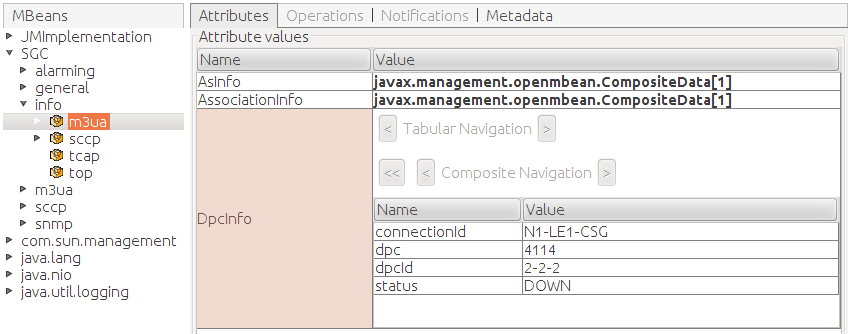|
|
MBeans exposing operational state
SS7 SGC Stack operational state is exposed through a set of JMX MBeans. Description of these MBeans and their naming conventions might be of interest to a user wishing to create a custom management tool for the SGC stack. |
Instance Management MBean
Each instance (node) of the SS7 SGC Stack exposes information that can be used to check the current instance configuration properties.
|
|
The JMX Object name for the MBean exposing this information is SGC:type=local.
|
This bean exposes following attribute and operations.
Properties attribute
The properties attribute is a collection of records. Each such record represents runtime properties of the currently connected SGC Stack instance (that is, the instance to which the JMX management client is connected). For more about instance configuration, please see Configuring the SS7 SGC Stack. Below are properties record fields:
| Name | Description |
|---|---|
|
property key |
|
property description |
|
value used if |
Operations
The results of JMX MBean operations invoked on the instance-management bean are local to the currently connected SGC Stack instance (that is, the instance to which the JMX management client is connected).
| Name | Description | ||
|---|---|---|---|
|
tests if the JMX RMI connector of the currently connected SGC Stack responds to the invocation of a JMX MBean operation |
||
|
attempts to shutdown the currently connected SGC Stack instance
|
Alarm MBean naming structure
Every type of alarm used by the SS7 SGC stack is represented by a separate MBean. The names of MBeans for SGC alarms use the common domain SGC and this set of properties: type, subtype, name. The values of type and subtype are the same for all alarm MBeans; the value of the name property represents a type of alarm. Whenever an actual alarm of a given type is raised, a new MBean representing that instance of the alarm is created. The name of that MBean has an additional property, id, which uniquely identifies that alarm instance in the SGC cluster.
For example, an alarm type representing information about an SCTP association (connection) going down has the MBean name SGC:type=alarming,subtype=alarm,name=associationDown. Whenever a particular association is down, the MBean representing the error condition for that particular association is created with a name such as SGC:type=alarming,subtype=alarm,name=associationDown,id=302, where the id property value is unique among all alarms in the cluster.
Most GUI-based JMX Management tools represent the naming space as a tree of MBean objects, like this:

Alarm raised and cleared notifications
Whenever SGC raises or clears an alarm, a JMX notification is emitted. To be notified of such events, each MBean representing an alarm type supports alarm.onset and alarm.clear notifications. An administrator can use a JMX management tool and subscribe to such events for each alarm type.
Here’s an example view of a JMX Management tool reporting received notifications:

Active alarms and alarm history
Besides alarm type-specific MBeans, the SS7 SGC stack exposes two generic MBeans that enable review of active alarms and history of alarms that where raised and subsequently cleared during cluster operation:
-
SGC:type=alarming,subtype=alarm-table— currently active alarms -
SGC:type=alarming,subtype=alarm-history— history of alarms
Alarm Table
The Alarm Table MBean contains a single attribute, EventList, which is a list of records representing attributes of currently active alarms. Alarm type-specific attributes are represented within a single parameters column.
Here’s an example view of Alarm Table MBean attributes in a JMX management tool:

The Alarm Table MBean exposes a clearAlarm operation that can be used to clear any raised alarm based on its id.
Alarm History
The Alarm History MBean contains a single attribute, AlarmHistory, which is a list of records representing attributes of raised and optionally cleared alarms within the last 24 hours (This period is customizable, as described in Configuring the SS7 SGC Stack). Alarm type-specific attributes are represented within a single parameters column. For each alarm that was raised and subsequently cleared, there are two records available in the list: one is generated when the alarm is raised (with a severity value other than CLEARED); the second record is generated when the alarm is cleared (with a severity value of CLEARED).
Information concerning notifications is also recorded in the Alarm History MBean.
The Alarm History MBean exposes a clear operation that can be used to clear all entries stored in the alarm history.
Notification MBean naming structure
Every type of notification used by the SS7 SGC stack is emitted by a separate MBean. SGC-alarm MBean names use the common domain SGC, and this set of properties: type, subtype, name. Values of type and subtype are the same for all notification MBeans; the value of the name property represents a type of notification.
For example, the MBean type emitting notifications about incoming SCCP-message decoding errors is represented by this MBean name: SGC:type=alarming,subtype=notif,name=sccpDecodeErrors. Whenever there is an error during decoding of an SCCP message, a JMX notification is emitted by this MBean. (Actually, for this specific notification, a single notification summarizes multiple errors over a specific time interval.)
Most GUI-based JMX Management tools represent the notification naming space as a tree of MBean objects, like this:

Statistics MBean naming structure
SGC statistics are exposed through a set of JMX Management MBeans. This section describes the MBean naming structure of subsystem statistics and processing object-specific statistics.
Subsystem statistics
SGC stack subsystems expose multiple JMX MBeans containing statistical information. SGC statistics MBeans names use the common domain SGC and this set of properties: module, type. The value of type is the same for all statistics MBeans; the value of the module property represents a subsystem. Attributes of these beans are arrays of records; each record contains statistical information related to a processing object configured within the SGC cluster (such as a particular SCTP association).
For example, the statistics MBean representing information about the M3UA subsystem (layer) is represented by the MBean named SGC:module=m3ua,type=info. This MBean has (among others) the attribute DpcInfo, which contains information about DPC (destination point code) reachability through a particular connection; for example:
| Attribute | Value |
|---|---|
|
|
|
|
|
|
|
|
Most GUI-based JMX Management tools represent the naming space as a tree of MBean objects, like this:

Processing object-specific statistics
The SGC stack also exposes processing object-specific MBeans, such as an MBean containing statistics created for each connection. Information exposed through such MBeans is exactly equivalent to that exposed through subsystem statistic MBeans. SGC processing object-specific MBean names use the common domain SGC and this set of properties: module, type, element, id.
-
The value of
typeis the same for all statistics MBeans. -
The value of
modulerepresents a subsystem. -
The value of
elemidentifies a group of processing objects of the same type (such as connections or nodes). -
The value of
ididentifies a particular processing object (such as a particular connection or particular node).
For example, the statistics MBean representing information about network reachability for a particular DPC through a particular connection in the M3UA subsystem (layer) is represented the MBean named SGC:type=info,module=m3ua,elem=dpcInfo,id=N1-LE1-CSG&4114. Information exposed through this MBean is exactly the same in the example above:
| Attribute | Value |
|---|---|
|
|
|
|
|
|
|
|
Most GUI-based JMX Management tools represent the naming space as a tree of MBean objects, like this:

